Ok we’re guilty. We’ve inserted William G. Giltzow’s 1951 photo of an unidentified Bugatti eagerly being worked on by a number of young American Bugatti enthusiasts into the cover of a classic book on the 8 cylinder touring Bugattis. Maybe it will help someone identify the mystery Bugatti. A good read in any case as you will see below in our archived book review.
Review by Pete Vack
Like most manufacturers, Bugatti was in business to make money by producing automobiles (and railcars), a fact that is often obscured by the brilliance of the Type 35, 55, and 57 Bugattis. And to be sure, those are the Bugattis that most often appear at vintage events, auctions and car shows; how easy it has become to overlook the bread and butter Bugattis that comprised the Types 30, 38, 44 and 49 line of straight eight touring cars.
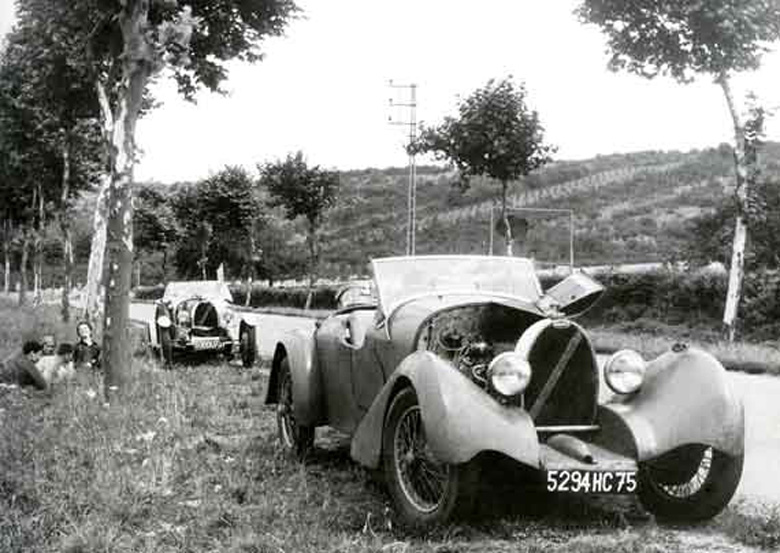
From the book, a charming roadside photo taken in 1958 somewhere in France; a T40 is in front of a T38. VeloceToday Reader Michel Van Peel recalls “travelling the roads of France during that period in my father’s Citroen DS and spotting many of prewar cars; Tractions, Peugeots 202 and 302 and the occasional Delahaye. But even then Bugattis were few and far between. The only one I can actually remember is a hand -painted type 57, probably a Ventoux, somewhere in central France.”
We have previously reviewed two books by Barrie Price, The Type 46 and 50, and then the Type 57 and 57S. We noted some of the problems with the books, but emphatically stated that both are not only well worth the small amount of money, but because of the large number of historical photos, absolutely essential for anyone interested in Bugattis. So it is with the third Barrie Price book Bugatti, The 8 Cylinder Touring Cars 1920-1934, Types 28, 30, 38, 38a, 44 and 49 for it is probably only at the National Museum at Mulhouse (The Schlumpf) that one can find such a treasure of Bugatti touring cars. It is written with Bugatti enthusiast Jean-Louis Arbey, who apparently was responsible for the captions in French. As a document, the book is uneven, eccentric, but nevertheless delightful, perhaps an inadvertent reflection of the Bugatti mystique.
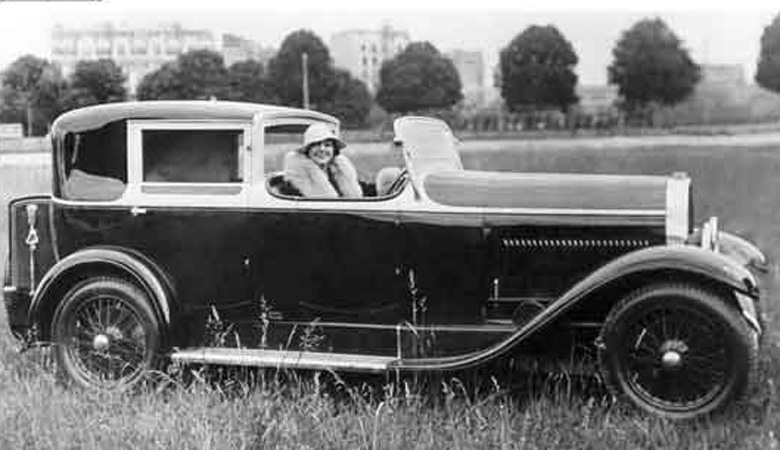
This T44 is typical of the rather upright style of these Bugattis, most built before the mid thirties streamlining craze.
The lengthy title leads one to expect a huge book, but it is only 160 pages. One wonders at the organization, but the grouping is logical, assuming one is familiar with the Bugatti line. But as with any car manufacturer, Bugatti nomenclature and models can get confusing. Here is an abridged list of the major touring Types between 1922 and 1939 with brief specs courtesy of the Bugatti Trust:
Types 13-23 Four cylinder cars built before and after WWI.
Type 28 Not a major model but a prototype luxury car with a straight eight that inspired the Type 30. Gearbox with differential. Only one made for show in 1921, now in the Schlumpf collection
Type 30 8C, SOHC, three valve, three main bearing, 2 liter that served as the basis for the T 35A race car. Barrel crankcase. 4 speed gearbox behind engine centrally placed. 600 touring versions built, 1922-26.
Type 32 Bugatti Tank, built for the French Grand Prix at Tours, 1923
Type 35 The famous 8 cylinder five main bearing, two liter GP car and its variants 210 built, 130 of the 35A Tecla
Type 37 Type 35 look alike but with four cylinders, usually wire wheels. 290 built.
Type 38 8C SOHC with 2 liter split crankcase. 4 speed gearbox behind engine centrally placed 385 built, 1926-27, 38A supercharged
Type 40 4C SOHC with both 1496cc, 1627cc blocks, 830 built 1926-30, 40 A supercharged
Type 41 8C, 12,763cc, “Royale”, 6 built
Type 43 8C Type 35 engine, “Grand Sport” , 160 built, 1927-31, supercharged
Type 44 8C SOHC with 9 plain bearings which made a significant improvement and up to 2991 cc. 4 speed gearbox behind engine. 1095 built.
Type 45 and 47 16C race and hillclimb cars
Type 46 8C SOHC Big Bugatti Touring car. 5,359cc, 444 built and 18 more supercharged
Type 49 8C SOHC twin plug, much like the 46 but with only 3257 cc. 4 speed gearbox behind engine centrally placed. 470 built
Type 50 8C DOHC 4972cc engine, supercharged, 65 built 1930-34
Type 55 8C DOHC, 2262cc, supercharged, “Grand Sport” 28 built 1932-35
Type 57 8C DOHC, 3257 cc last of the great Bugattis; 630 built.
Now that we have some reference, we can see that the majority of the Bugatti line consisted of the often-upright (most designed prior to the streamlining era) Types 30, 38, 44 and 49, with about 2550 cars constructed between 1926 and 1934. Those are the cars addressed by the Price/Arbey book we review here.
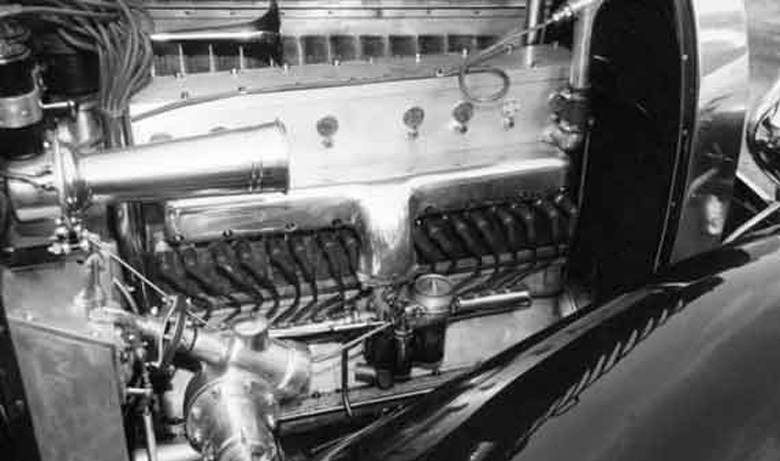
The classic square-cut Bugatti eight of the 1930s. This is a Type 49, SOHC, two plugs per cylinder, unblown with an American Schebler carburetor.
They were all straight eights; Bugatti did not favor the six, and opted for the smooth power of the then very popular eight. He was the only manufacturer of straight eight luxury cars to survive the Depression; Isotta Fraschini and Duesenberg, didn’t make it, largely because they concentrated on solely on luxury eights. Bugatti endured because of the French railcar project; he had unwisely stopped producing the four cylinder Bugattis in 1933, the year the Depression really hit home in France.
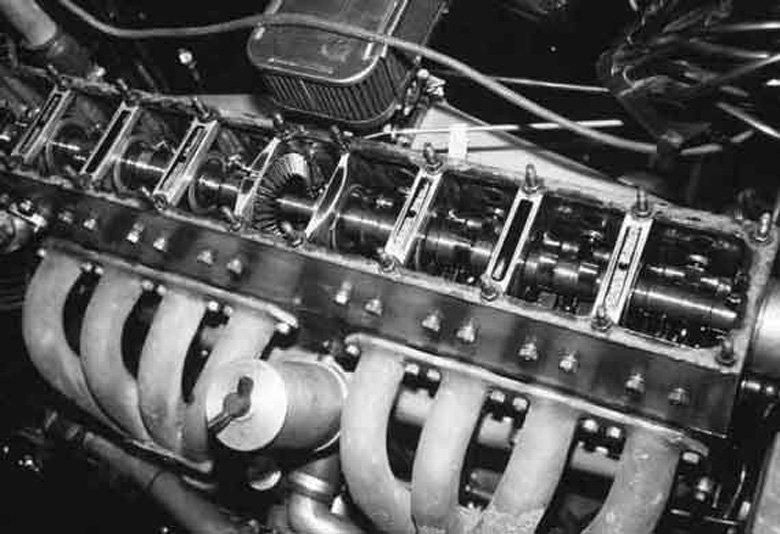
Take that, Mr. Jano! A T49 reveals the central camshaft drive used by Bugatti on many eights. Yet the book does not have a diagram or engine drawing which further explains the cam drive layout.
Despite its famed smoothness (the reputed silky smoothness of the straight eight was probably in comparison to the contemporary very lumpy large displacement four cylinders), the straight eight had balancing problems which were never fully resolved. While the original Type 28 had a nine bearing crank, the Type 30s made due with a three main bearing crankshaft. Eventually a plain nine bearing crankshaft was again used on the Type 44 and 49. All of these touring cars had a three valves per cylinder SOHC head and a 4 speed gearbox behind engine, instead of combined with the differential as on the Type 46 and 50. The major differences included the type of crankcase, number of main bearings, displacement, number of plugs and firing order; chassis remained the traditional Bugatti front axle and quarter elliptic springs with a solid axle at the rear. And despite, or because of, a brief interlude with hydraulic brakes in the 1920s, these touring cars all had cable operated brakes.
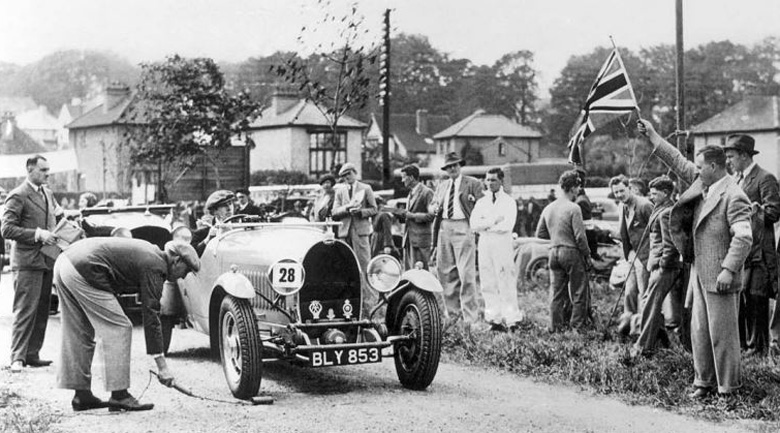
The book includes an interesting chapter on “Eight Cylinder Touring Cars in Competition”, with a series of rare photos of the T32 (Tank), T30, T38, T44 and as pictured here, A T49 with a Corsica body. A list of victories won with the T44 is most impressive and Price notes the famous Trasenster T44 which won the difficult Liège-Rome-Liège race three times! That car is now in the capable hands of Belgian collector Reginald Ghys.
Despite being short on specs, the book does have some very interesting and enlightening chapters:
Type 44 Development
Technical appraisal of the T44 Chassis
New Car Prices
Ordering a Bugatti in the Thirties
Driving Bugattis in the Thirties
Interesting, but most are too short! We are reminded of how difficult it was to travel in the 1930s, how the bodies sagged and creaked and many of the cars, even the best of them, went to the junkyard; and how the prices of used Bugattis fell accordingly.
Price provided this telling chart of known surviving Types:
Type 30 600 built 34 survived as of 2007
Type 38 385 built 42 survived
Type 44 1095 built 165 survived
Type 49 470 built 103 survived
Of further interest is the manner in which the over 200 B&W (there are no color images in the book) photos are listed. By Type? By year? By Serial Number? Nah, how about by body type; Fiacre, Fixed Head Coupes, Saloons, Cabriolets, and so on, aside from a chapter on Gangloff. Most of the cars are identified by Type and or S/N in the captions, although there are a few that defy even the expertise of the authors. And unlike the previous two books, Price has not included a factory serial number compendium, though we don’t know why not.
Become a Premium Subscriber to VeloceToday! Click here.
It is handy to have another reference book when reading the Price books. One such (despite some imperfections) is Bugatti, The Man and the Marque by Jonathan Wood, Crowood Press, 2007, while the Bugatti Trust has an excellent section listing each model with full specs.
The Price books form a basis for a good library of Bugatti books and are still reasonably priced. Next up will be the Price Bugatti Type 40; this one is out of print currently and used copies begin at $75 USD and only $52.00 USD when it was available new from the publisher.
Buy this book? You bet.
Bugatti – The 8-Cylinder Touring Cars 1920-1934 – Types 28, 30, 38, 38a, 44 & 49
By Barrie Price & Jean-Louis Arbey
207mm wide by 250mm tall • 160 pages • 231 Pictures
ISBN: 9781901295955
£ 30.00 $42.00 USD plus shipping (for eBooks this varies and delivery is free)
Veloce Publishing, 2007
Telephone – +44 (0)1305 260068
Facsimile – +44 (0)1305 250479
E-mail – info@veloce.co.uk
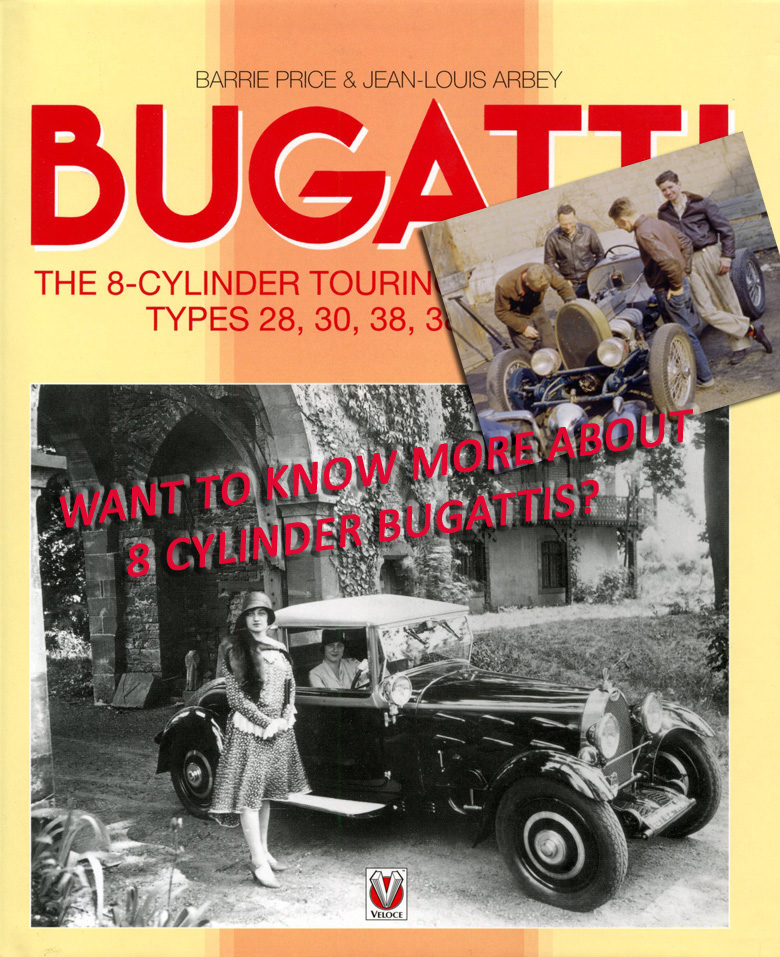
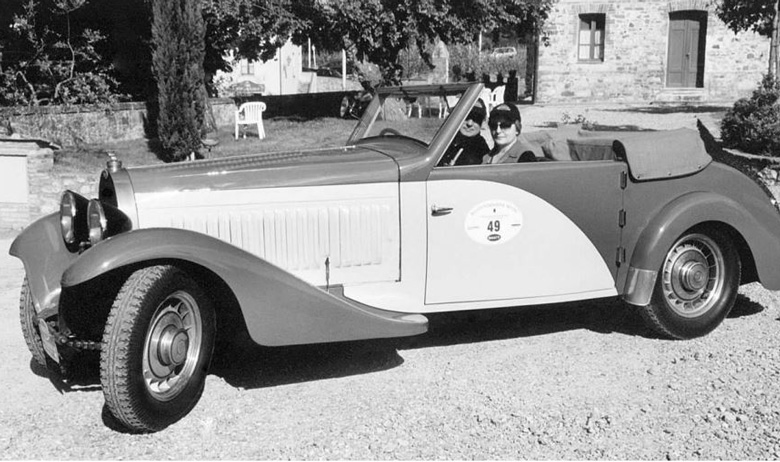
Did anyone find the Bugatti that Mrs Junek of Prague raced? I met her once after WWII and she still had a Bugatti and let me sit in it. I was about 10 or 11.
Just curious Paula
Again and Again, Pete,
A neat Bug story, with all the great data on them. I never know much about Buggati’s until Watkins Glen back in 1950. Keep up the great work.